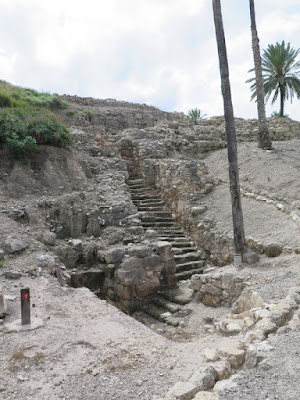
Meggido is located about 12 miles southwest of Mount Tabor. During the Biblical period, Megiddo was one of the most important cities in the country. Its location allowed it to control the outlet of the Iron Valley to the Jezreel Valley and the Via Maris (the Way of the Sea), an international trade route that linked the ancient world's centers of culture and power - Egypt and Mesopotamia.
To give a sense of the size of the community, when King Thutmose III of Egypt conquered Megiddo 3,500 years ago, he left with nearly 2,000 head of cattle, 2,000 goats, 20,500 sheep, 204 horses, 200 army uniforms and 500 bows.
Megiddo is first mentioned in the Bible in Joshua 12:21. At the time the city was inhabited by Canaanites. The city later came under the control of King Solomon, though there is some controversy as to how much of a connection he had to the remains that have been discovered. The Israelite connection to the city ended around 732 B.C.E. when the Assyrians conquered Palestine. Though the city was destroyed and rebuilt several more times, it gradually declined in significance. Most recently, Megiddo was the place where British General Allenby launched his attack against the Turks in 1917. It also served as a base for Israeli forces in the 1948 war.
Archaeologists working in Megiddo have unearthed an incredible 25 layers of settlement built on top of each other that cover a period of 35 centuries.
Today, water is considered vital to the security and survival of Israel. That this has been true since ancient times is evident in many archaeological sites throughout the country, including Megiddo. Here, an ingenious system was devised so the townspeople would not have to leave the safety of the city walls to collect water. A vertical shaft was dug within the city to the depth of the nearby spring and then a tunnel was built connecting to the water source.
You can walk down 183 steps into the shaft, which is 120 feet deep, and then along the tunnel, which stretches another 215 feet.
Drs. Allred, Muhlestein, and Skinner lead discussions along the way and helped us better understand the history of this site. This was the location of Solomon's temple.
One of the interesting parts of the excavation is the chariot stables, called Solomon's Stables even though we now know they were built by King Ahab during the 9th century B.C.E. The only parts that remain are the posts where the horses were apparently tied and water troughs.
Note: See the line or mortar in the stones? The stones above that line were found and added to the layers of the wall but those below the line were as they were found during the dig at the excavation.
Photo: Mikelle, Jerusalem Center student
Megiddo has been the scene for battles involving some of the world's great conquerors: Pharoahs, Kings David and Solomon, Alexander the Great and Napoleon to name a few.
Photo below: view from tower at Megiddo.
The city is referred to in the New Testament as Armageddon. According to the book of Revelation, this the place where the last great battle will be fought when the forces of good will triumph over evil. Visiting places like this makes the scriptures come to life and just reading about these places isn't as nearly as interesting.





















